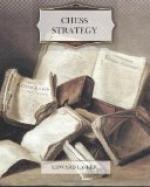The pieces move in the following way: The Rook can move from any square it happens to be on, to any other square which it can reach in a straight line, either perpendicularly or horizontally, unless there is another piece of the same colour in the way, in which case it can only move as far as the square immediately in front of that piece. If it is an opposing piece which blocks the way, he can move on to the square that piece occupies, thereby capturing it. The piece thus captured is removed from the board. The Bishop can operate along either of the diagonals of which the square on which he is standing forms part. A Bishop on a White square can there fore never get on to a Black one.
--------------------------------------- 8 | #R | #Kt| #B | #Q | #K | #B | #Kt| #R | |---------------------------------------| 7 | #P | #P | #P | #P | #P | #P | #P | #P | |---------------------------------------| 6 | | | | | | | | | |---------------------------------------| 5 | | | | | | | | | |---------------------------------------| 4 | | | | | | | | | |---------------------------------------| 3 | | | | | | | | | |---------------------------------------| 2 | ^P | ^P | ^P | ^P | ^P | ^P | ^P | ^P | |---------------------------------------| 1 | ^R | ^Kt| ^B | ^Q | ^K | ^B | ^Kt| ^R | --------------------------------------- a b c d e f g h
Diag. 1.
The Queen commands both the straight and the oblique lines which start from the square she stands on, and therefore unites the power of both Rook and Bishop in her movements.
The King has similar powers to the Queen, but curtailed, inasmuch as he can only move one step at a time. He therefore only controls one neighbouring square in any direction.
The Knight plays and captures alternately on White and Black squares, and only reaches such squares as are nearest to him without being immediately adjacent; his move is as it were composed of two steps, one square in a straight line, and one in an oblique direction. Diagram 2 will illustrate this.
[Footnote: I should like to quote my friend Mr. John Hart’s clever definition of the Knight’s move, though it may not be new. If one conceives a Knight as standing on a corner square of a rectangle three squares by two, he is able to move into the corner diagonally opposite.]
The pawns only move straight forward, one square at a time, except at their first move, when they have the option of moving two squares. In contrast to the pieces, the pawns do not capture in the way they move. They move straight forward, but they capture diagonally to the right and left, again only one square, and only forward. Therefore a pawn can only capture such pieces or pawns as occupy squares of the same colour as the square on which it stands. If, in moving two squares, a pawn traverses a square on which it could have been captured by a hostile pawn, that pawn has the right to capture it, as if it had moved only one square. This is called capturing en passant. However, this capture can only be effected on the very next move, otherwise the privilege of capturing en passant is lost.




